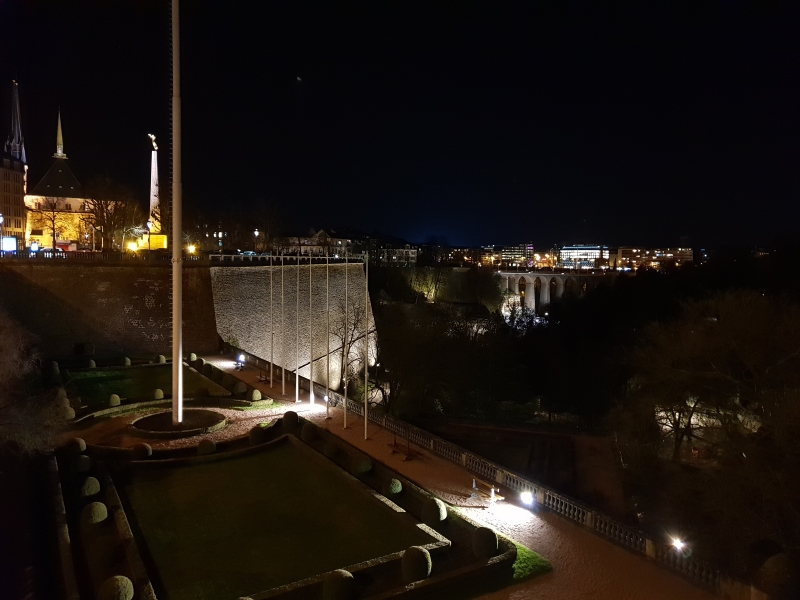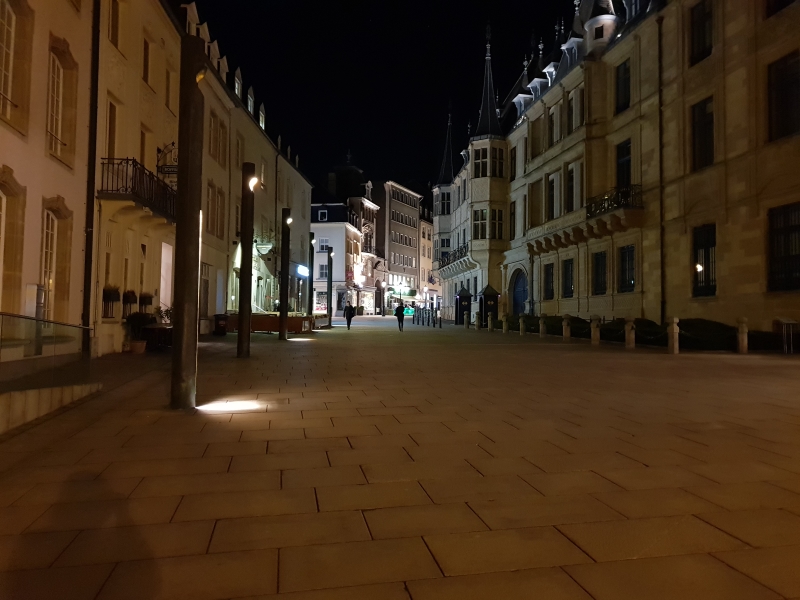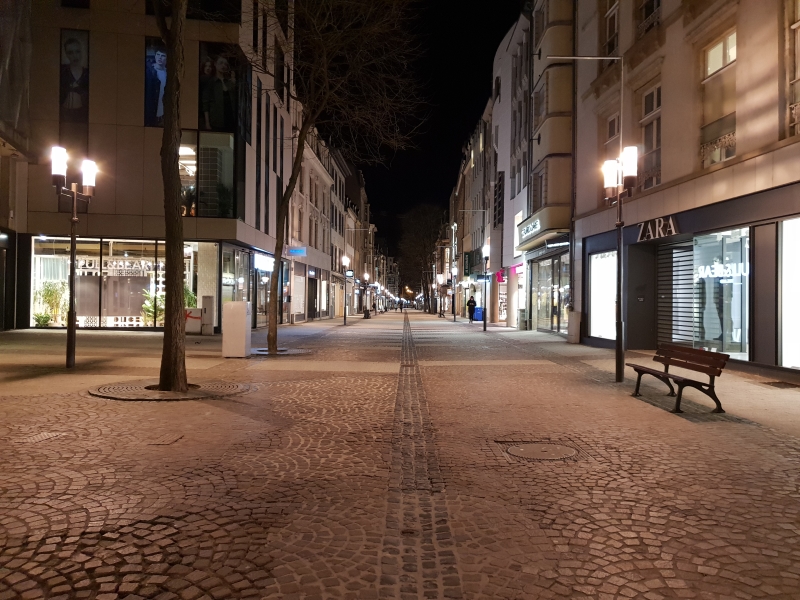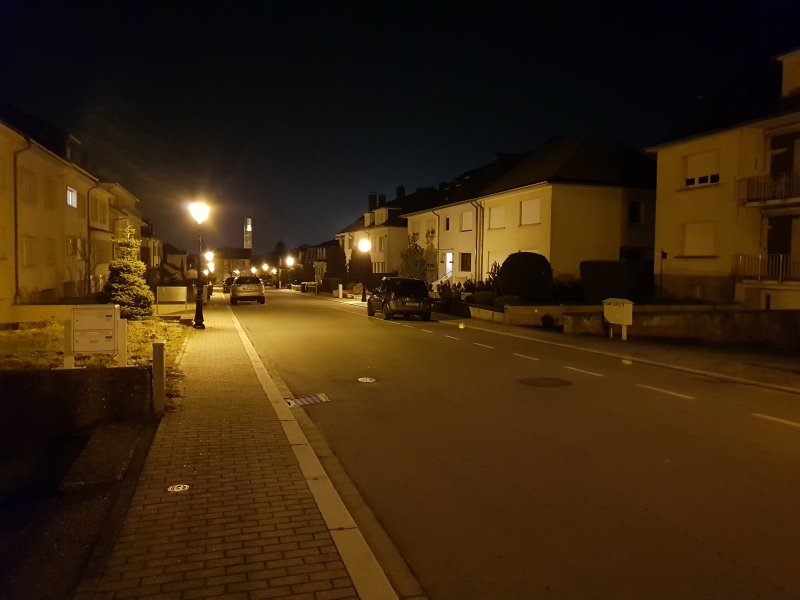The Samsung Galaxy S9 and S9+ Review: Exynos and Snapdragon at 960fps
by Andrei Frumusanu on March 26, 2018 10:00 AM ESTCamera - Low Light Evaluation
We move onto low light shots. This is the part where we have large expectations of the S9 as the new wider aperture and multi-frame noise reduction processing promise great improvements in quality.
[ Galaxy S9 ] - [ Galaxy S8 ] - [ Galaxy S7 ]
[ Pixel 2 XL ] - [ Pixel XL ] - [ P10 ]
[ Mate 9 ] - [ Mate 10 ] - [ G6 ] - [ V30 ]
[ iPhone 7 ] - [ iPhone 8 ] - [ iPhone 8 Plus ] - [ iPhone X ]
In this scene again to give the best apples-to-apples comparison between the devices I shot the samples at different exposure modes, focusing on different parts of the pictures.
The scene was naturally very dark and the Galaxy S9 in auto mode did a good representation of this. However this is still too dark for actual picture usages on a monitor so focusing on a darker part of the scene brought up the exposure and details in the darkness. Against the S8 the S9 gains details in the shadows but otherwise the two phones post very similar processing with the S9 being in the lead.
In terms of the competition the Pixel phones are clearly the devices to beat here. Google is able to retain a lot more details in textures as the phones use far less heavy processing. This results in a noisier picture than the Galaxy S9 but I think it’s overall better because of the detail retention. The iPhone 8 as well uses less processing and sharpening, able to retain more of the natural textures of the scene, again, at the cost of higher noise.
Which phone is best will come down to preference as the different phones have different compromises. The S9 is sharp and bright with little noise, but loses on texture detail. The Pixels and iPhones are noisier but retain better the textures of the scene.
[ Galaxy S9 ] - [ Galaxy S8 ] - [ Galaxy S7 ] - [ Pixel 2 XL ]
[ Pixel XL ] - [ P10 ] - [ Mate 9 ] - [ Mate 10 ] - [ G6 ]
[ V30 ] - [ iPhone 7 ] - [ iPhone 8 ] - [ iPhone 8 Plus ] - [ iPhone X ]
In the second low-light scene we have another challenging scenario with a lot of dark area and a few highlights.
Here the Galaxy S9 dominates the competition as it produces by far the best results. The processing style is similar to the S8 however the S9 just produces more detail and less noise. Google’s Pixel devices did not do well at all in this shot and the result is a fuzzy noise picture even though light capture and dynamic range seems adequate. The Pixel phones did manage the best colour representation of the sodium lamps, although it doesn’t rescue the end result. The new iPhones do a good job, but it’s not enough against the Galaxy S9 or even S8.
The best contender against the S9 here is in my opinion the V30 as although it produces less light than the S9, it manages to retain a great amount of detail on the bridge, at least compared to all other phones. The V30 here also sees a comparison shot with the new “Bright Mode” that was introduced with a firmware update following the MWC announcement of the V30s. This allows for 2x2 pixel binning and increased light capture, but naturally with a resulting picture which has only 1/4th of the pixels and thus much less detail.
[ Galaxy S9 ] - [ Galaxy S8 ] - [ Galaxy S7 ] - [ Pixel 2 XL ]
[ Pixel XL ] - [ P10 ] - [ Mate 9 ]
[ Mate 10 ] - [ G6 ] - [ V30 ]
[ iPhone 7 ] - [ iPhone 8 ] - [ iPhone 8 Plus ] - [ iPhone X ]
The next scenic scene has a lot more lights scattered through the frame. The Galaxy S9 again noticeably improves the sharpness over the Galaxy S8 while retaining the same colour tones and overall processing. The Pixels didn’t do well in terms of colour balance and also have less detail than the S9 and iPhones. The new iPhones are indeed the contenders for second spot here as the iPhone 8’s and X beat the Galaxy S8 in terms of detail, but fall short of the S9’s capabilities. The V30 also did extremely well in preserving detail and noise, however like in the last scenario comes at the prices of darker shadows with less features.
[ Galaxy S9 ] - [ Galaxy S8 ] - [ Galaxy S7 ] - [ Pixel 2 XL ]
[ Pixel XL ] - [ P10 ] - [ Mate 9 ]
[ Mate 10 ] - [ G6 ] - [ V30 ]
[ iPhone 7 ] - [ iPhone 8 ] - [ iPhone 8 Plus ] - [ iPhone X ]
This scene with a lit statue even when looking close is hard to differentiate between the S9 and S8. The S9 does an ever so slightly brighter image and better detail retention, but the differences aren’t that big. The Pixel phones and the Pixel 2 in particular produce a much brighter image with the larger dynamic range, however this comes at a cost of lack of sharpness and more noise. The V30 follows the S9 in terms of overall exposure and in terms of details it seems a tie between the more processed S9 and the softer, but higher resolution of the V30. The S9 does better in the highlights. The iPhones do a brighter picture than the S9, but lose in terms of details and noise.
[ Galaxy S9 ] - [ Galaxy S8 ] - [ Galaxy S7 ] - [ Pixel 2 XL ]
[ Pixel XL ] - [ P10 ] - [ Mate 9 ]
[ Mate 10 ] - [ G6 ] - [ V30 ]
[ iPhone 7 ] - [ iPhone 8 ] - [ iPhone 8 Plus ] - [ iPhone X ]
The next scene follows the characteristics of the last one. The Galaxy S9 does ever so slightly better than the S8. The Pixels again retain more light but with a resulting fuzzy picture. The V30 and new iPhones are the real contenders to the Galaxy S9 with the V30 taking second place to the S9.
[ Galaxy S9 ] - [ Galaxy S8 ]
[ Pixel 2 XL ] - [ Pixel XL ] - [ P10 ] - [ Mate 9 ]
[ Mate 10 ] - [ G6 ] - [ V30 ]
[ iPhone 7 ] - [ iPhone 8 ] - [ iPhone 8 Plus ] - [ iPhone X ]
This scene is a lot brighter than the previous scenarios due to the street lighting, so the quality of the results should mostly fall onto the characteristics of the camera processing.
Between the Galaxy S9 and S8 we see the same overall picture exposure level. The S9 is able to achieve a higher dynamic range and less blown-out highlights of the street lamps thanks to its wider aperture and quicker exposure time, compared to the S8. While at first glance the pictures are similar, when looking at the details it seems as though the S9 regresses on the details compared to the S8. This is especially visible in the foreground objects such as the pavement or the shop front on the left. This loss of detail is less pronounced further in the middle of the image and down the street so I think what’s happening is that the S9’s shallower depth-of-field because of the wider aperture is working against its favour in this shot.
The Pixels again don’t retain enough detail so can’t compete against the S9 and S8. The iPhones showcase an extremely close exposure to Samsung’s phones. Apple’s devices are very close to the S9 in the foreground but lose out in detail further down when the S9 is in its optimal focal plane. The V30 produces an overall darker image, but this helps with preserving the highlights. In terms of detail it’s relatively even to the S9 but it depends on which parts of the picture are being compared as they have different exposures.
[ Galaxy S9 ] - [ Galaxy S8 ] - [ Galaxy S7 ]
[ Pixel 2 XL ] - [ Pixel XL ] - [ P10 ] - [ Mate 9 ]
[ Mate 10 ] - [ G6 ] - [ V30 ]
[ iPhone 7 ] - [ iPhone 8 ] - [ iPhone 8 Plus ] - [ iPhone X ]
The last scene is about sheer light capture and to see who resolves best the shadowy-details. In this scene the Galaxy S9 makes full use of its wider aperture and provides a lot more clarity and less noise than the S8. The Pixels do a gain a much better job at capturing the correct colour balance of the sodium lamps but, but again can’t compete in terms of detail. The V30 continues its trend of producing darker images which helps keep down noise and still retain a respectable amount of detail, however just can’t bring out features in the shadows. This leaves the new iPhones as the only contenders. Apple, similarly to Google, does a better job than Samsung in terms of colour temperature. When it comes to detail, the iPhone 8’s and X are more on the level of the Galaxy S8 and the S9 retains its lead.
Overall the Galaxy S9 provided the best low-light shots among the test smartphones through its ability to retain more detail. In dark scenes the S9 doesn’t have the same consistency issues that we saw in the day-light shots and I found the S9, similarly to its predecessors, to provide a good a repeatable experience. The advantages over the S8 will depend on lightning and scenery. In the worst low-light scenarios the S9 will hold a good lead over the S8, but in other scenarios when there’s a bit more light the differences are less pronounced. There’s some rare cases where the S9 could do worse than the S8 and that’s simply due to the nature of the optics and the shallower depth of field of the F/1.5 lens.
In terms of competition, I think Apple’s new iPhones are overall the most competitive against the S9 in low-light and showed the best balance across the shots. Google had the best low-light colour balance, but in some scenes just had too much noise resulting in fuzzy images. Huawei in general had a tough time competing and their monochrome sensor solution just didn’t work out. LG’s phones were very good as well however Samsung edged them in in detail.



























































190 Comments
View All Comments
phoenix_rizzen - Monday, March 26, 2018 - link
S6 and S7 in Canada are the Exynos version. We have both in our home (well, the S6 is dead now).madseven7 - Wednesday, March 28, 2018 - link
Since when? Canada has always been Snapdragon. Check againphoenix_rizzen - Monday, April 2, 2018 - link
Since the S6 and the S7.The S4 and Note4 (only other Samsung offices we've had) were Qualcomm, but the Galaxy S6 and S7 were Exynos.
Samsung Galaxy S6 SM-G920W8
Samsung Galaxy S7 SM-G930W8
Phonemore.com and XDA lists them both as Exynos. And when I check About on the phone in my hand, that's what it shows as well.
Based on that trend, I figured we'd be getting the Exynos versions of future Galaxy phones in Canada.
phoenix_rizzen - Monday, April 2, 2018 - link
Looks like for the S8 and the S9 they've switched back to Qualcomm for Canada.SM-950W (S8)
SM-965W (S9)
Raqia - Monday, March 26, 2018 - link
Thanks for the excellent in depth report. I think you're being a bit unfair to the cache architecture of the S845: adding any cache at all will add latency when accessing DRAM instead of having none at all. There are use cases where additional cache is useful, and although any accesses that spill over into DRAM pay a penalty, anything prior to that sees quite a benefit.Is that much of the performance deficit of the 9810 in the "System Performance" in every test attributable to DVFS? Surely the Javascript related benchmarks like Speedometer and WebXPRT are running full tilt without so many UI calls?
jospoortvliet - Tuesday, March 27, 2018 - link
Sure but if the CPU takes half a sec to get up to speed the bench that takes a second for each part is as ruined as is real life performance...Wardrive86 - Monday, March 26, 2018 - link
Interesting that the Adreno 630's sustained performance is close to the Mali's peak performance in many of those benchmarks. Also Are Adreno 500 series gpus 64 ALU per core?iamjekk - Monday, March 26, 2018 - link
Well written article as always. Excellent job! Keep it up!lopri - Monday, March 26, 2018 - link
On the SPEC page;"One thing to note as interesting is the difference in scaling on the Exynos 9810 and Snapdragon 845 between both integer and floating point average power. Samsung’s power only increases 8% for floating point while Qualcomm/ARM’s solution sees a larger 30% jump. I don’t know if this points out to more efficient floating point execution engines on Samsung’s part or if ARM has the more efficient integer core."
I have no clue where these numbers come from looking at the tables.
tuxRoller - Monday, March 26, 2018 - link
The first table after the fp results (or, equivalently, the table following that paragraph).Ratio of fp to int for each respective SoC.